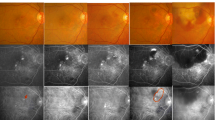Abstract
Background
The pathogenesis of polypoidal choroidal vasculopathy (PCV), and even its clinical features, are controversial. Previous histopathological studies have identified different features; either dilated choroidal vessels or intra-Bruch’s neovascularization. These differences might be partly attributable to the influence of the disease stage. We therefore evaluated the clinical features of early and late stage PCV.
Methods
The medical records of 110 eyes of 97 PCV patients were retrospectively reviewed. The time between the subjective onset of visual abnormality and examination at our clinic and the greatest linear dimension of the total lesion at the first examination were investigated. The period of disturbed vision and lesion size data were placed in ascending order to determine the first quartile point. Eyes with both values at or below the first quartile point were classified as ‘small–short’ (early stage). Eyes with both values equal to at least the third quartile point were classified as ‘large–long’ (late stage). Fundus photography, indocyanine green and fluorescein angiography, visual acuity, and clinical course were compared.
Results
Twelve eyes from 12 patients were small-short cases (period of disturbed vision of 1 month or less, lesion size 2.0 disc diameters or less). Eleven eyes from ten patients were large-long cases (period of disturbed vision 36 months or more, lesion size at least 5.0 disc diameters). The large-long eyes were characterized by occult choroidal neovascular membrane or scar tissue secondary to exudative age-related macular degeneration. Noticeable in the small-short eyes were atrophic changes in the retinal pigment epithelium, choroidal vessel hyperpermeability and pulsation. The visual prognosis and clinical course were different between the groups.
Conclusions
The difference of clinical features between the groups might reflect different disease stages, although not all of the features observed in the small-short group appeared to represent the early stages of those recorded in the large-long group. Thus, the variation in histopathologic features among previous reports might be partly attributable to differences in disease stage.






Similar content being viewed by others
References
Stern RM, Zakov ZN, Zegarra H, Gutman FA (1985) Multiple recurrent serosanguineous retinal pigment epithelial detachments in black women. Am J Ophthalmol 100:560–569
Yannuzzi LA, Sorenson J, Spaide RF, Lipson B (1990) Idiopathic choroidal vasculopathy (IPCV). Retina 10:1–8
Kleiner RC, Brucker AJ, Johnston RL (1990) The posterior uveal bleeding syndrome. Retina 10:9–17
Perkovich BT, Zakov ZN, Berlin LA, Weidenthal D, Avins LR (1990) An update on multiple recurrent serosanguineous retinal pigment epithelial detachments in black women. Retina 10:18–26
Uyama M, Matsubara T, Fukushima I, Matsunaga H, Iwashita K, Nagai Y, Takahashi K (1999) Idiopathic polypoidal choroidal vasculopathy in Japanese patients. Arch Ophthalmol 117:1035–1042
Kwok AK, Lai TY, Chan CW, Neoh EL, Lam DS (2002) Polypoidal choroidal vasculopathy in Chinese patients. Br J Ophthalmol 86:892–897
Sho K, Takahashi K, Yamada H, Wada M, Nagai Y, Otsuji T, Nishikawa M, Mitsuma Y, Yamazaki Y, Matsumura M, Uyama M (2003) Polypoidal choroidal vasculopathy: incidence, demographic features, and clinical characteristics. Arch Ophthalmol 121:1392–1396
Wen F, Chen C, Wu D, Li H (2004) Polypoidal choroidal vasculopathy in elderly Chinese patients. Graefe’s Arch Clin Exp Ophthalmol 242:625–629
Yannuzzi LA, Ciardella A, Spaide RF, Rabb M, Orlock DA (1997) The expanding clinical spectrum of idiopathic polypoidal choroidal vasculopathy. Arch Ophthalmol 115:478–485
Spaide RF, Yannuzzi LA, Slakter JS, Sorenson J, Orlach DA (1995) Indocyanine green videoangiography of idiopathic polypoidal choroidal vasculopathy. Retina 15:100–110
Yuzawa M, Mori R, Kawamura A. (2005) The origins of polypoidal choroidal vasculopathy. Br J Ophthalmol 89:602–607
MacCumber MW, Dastgheib K, Bressler NM, Chan CC, Harris M, Fine S, Green WR (1994) Clinicopathologic correlation of the multiple recurrent serosanguineous retinal pigment epithelial detachments syndrome. Retina 14:143–152
Spraul CW, Grossniklaus HE, Lang GK (1977) Idiopathische polypose choroidale Vaskulopathie (IPCV). Klin Monatsbl Augenheilkdd 210:405–406
Lafaut BA, Aisenbrey S, Van den Broecke C, Bartz-Schmidt KU, Heimann K (2000) Polypoidal choroidal vasculopathy pattern in age-related macular degeneration. A clinicopathologic correlation. Retina 20:650–654
Terasaki H, Miyake Y, Suzuki T, Nakamura M, Nagasaka T (2002) Polypoidal choroidal vasculopathy treated with macular translocation: clinical pathological correlation. Br J Ophthalmol 86:321–327
Rosa RH Jr, Davis JL, Eifrig CW (2002) Clinicopathologic correlation of idiopathic polypoidal choroidal vasculopathy. Arch Ophthalmol 120:502–508
Kuroiwa S, Tateiwa H, Hisatomi T, Ishibashi T, Yoshimura N (2004) Pathologic features of surgically excised polypoidal choroidal vasculopathy membranes. Clin Exp Ophthalmol 32:292–302
Okubo A, Sameshima M, Uemura A, Kanda S, Ohba N (2002) Clinicopathological correlation of polypoidal choroidal vasculopathy revealed by ultrastructural study. Br J Ophthalmol 86:1093–1098
Nakajima M, Yuzawa M, Shimada H, Mori R (2004) Correlation between indocyanine green angiographic findings and histopathology of polypoidal choroidal vasculopathy. Jpn J Ophthalmol 48:249–255
Green WR, Enger C (1993) Age-related macular degeneration histopathology studies. The 1992 Lorenz E. Zimmerman Lecture. Ophthalmology 100:1519–1535
Okubo A, Ito M, Sameshima M, Uemura A, Sakamoto T (2005) Pulsatile blood flow in the polypoidal choroidal vasculopathy. Ophthalmology 112:1436–1441
Author information
Authors and Affiliations
Corresponding author
Additional information
Grant information: This work was supported by research grant number 19592028 from the Japanese Ministry of Education, Science, Sports, and Culture.
Disclosures: The authors report no conflicting interests.
Rights and permissions
About this article
Cite this article
Okubo, A., Hirakawa, M., Ito, M. et al. Clinical features of early and late stage polypoidal choroidal vasculopathy characterized by lesion size and disease duration. Graefes Arch Clin Exp Ophthalmol 246, 491–499 (2008). https://doi.org/10.1007/s00417-007-0680-8
Received:
Revised:
Accepted:
Published:
Issue Date:
DOI: https://doi.org/10.1007/s00417-007-0680-8




